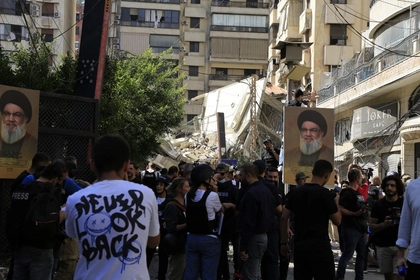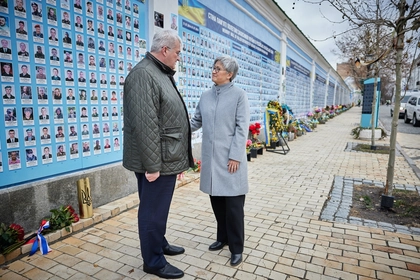Israel’s “limited and localized” invasion of Lebanon has highlighted the impressive strategic and tactical intelligence capabilities of the Israel Defense Forces (IDF), combined with the region’s most refined command and control structure.
At the heart of this campaign lies an extraordinary synergy of intelligence gathering, operational planning, and rapid execution, which has taken both Hezbollah and the broader regional actors by surprise. This operational mastery offers vital lessons for Ukraine as it contends with Russian forces, especially in terms of disrupting and degrading the enemy’s leadership and command.
JOIN US ON TELEGRAM
Follow our coverage of the war on the @Kyivpost_official.
The preparatory phase of the IDF’s operation, which some have dubbed “Operation Grim Beeper,” serves as a case study in precision-targeted intelligence warfare. The IDF systematically identified and neutralized Hezbollah figures crucial enough to carry key communication devices, beepers, effectively severing the group’s ability to command and coordinate. This operation, which will undoubtedly be dissected by intelligence agencies globally for years to come, laid the groundwork for Israel’s campaign by paralyzing Hezbollah’s command structure before hostilities even began.
Ukraine, faced with a heavily centralized Russian military command, could employ a similar strategy, focusing on key Russian officers and critical decision-makers to disrupt Moscow’s battlefield cohesion.

Canada’s Chrystia Freeland – A Personal View
Following this intelligence-driven groundwork, the IDF launched deep reconnaissance operations and strategically eliminated senior Hezbollah commanders, further degrading the organization’s ability to respond coherently. By leveraging satellite imagery, signal intercepts, and human intelligence, Israel developed a detailed map of Hezbollah’s command nodes, weapons depots, and underground networks. This comprehensive intelligence picture enabled Israel to conduct a series of preemptive, precision strikes that neutralized critical threats even before Hezbollah could mount a coordinated defense.
For Ukraine, employing a similar approach, targeting Russian high command and operational leaders, could severely disrupt Russian coordination and force Russia into a reactive stance, thus gaining the initiative in contested areas.
Ukraine’s adoption of a doctrine emphasizing the targeting of high-value Russian personnel could ultimately shift the balance in its favor, causing fear and chaos within the Russian military…
Once hostilities commenced, the IDF’s integration of air, land, and cyber assets enabled simultaneous operations on multiple fronts. The IDF’s heavy artillery barrages targeted border towns, while precision airstrikes struck deep within Lebanon. The seamless coordination between these assets facilitated by advanced communication networks and real-time data sharing ensured that operations were executed with surgical precision and minimal collateral damage.
This level of integration and coordination offers a blueprint for Ukraine to optimize its own command and control systems, combining intelligence assets with precision-strike capabilities to maximize effectiveness while limiting civilian casualties.
The significance of Israel’s campaign in Lebanon lies in how it demonstrates the potency of intelligence-driven warfare. The IDF’s operations did not merely focus on battlefield supremacy but extended to undermine Hezbollah’s very organizational framework.
This is where Ukraine could gain the most value: by identifying and targeting key Russian figures and assets, Ukraine can shift the war’s dynamic, forcing Russia to constantly replace and reposition its leadership. Such a strategy would have a cascading effect on Russian forces’ morale and operational cohesion, which are already hanging by a thread, forcing Moscow to divert resources and effort away from offensive operations and towards plugging gaps in its command structure.
Ukraine’s success in this regard hinges on its ability to integrate its own intelligence, surveillance, and reconnaissance (ISR) capabilities with precision-strike assets. Once permission to attack targets in Russia with Western weapons is granted, the Armed Forces of Ukraine (AFU) could achieve devastatingly effective results and bring this war closer to an end.
The IDF’s success was not simply a matter of having good intelligence but its ability to rapidly translate that intelligence into effective action. For Ukraine, the challenge is to develop an ISR infrastructure capable of generating actionable intelligence and to use that intelligence in a way that maximizes the impact of each strike.
In essence, the IDF’s operation in Lebanon exemplifies a masterclass in modern warfare, where superior intelligence feeds into a well-oiled command structure, enabling flawless execution.
Ukraine’s adoption of a similar doctrine, emphasizing the targeting of high-value Russian personnel, integrating multi-domain operations, could ultimately shift the balance in its favor, causing fear and chaos within the Russian military and disrupting Moscow’s broader strategy.
The views expressed in this opinion article are the author’s and not necessarily those of Kyiv Post.
You can also highlight the text and press Ctrl + Enter






